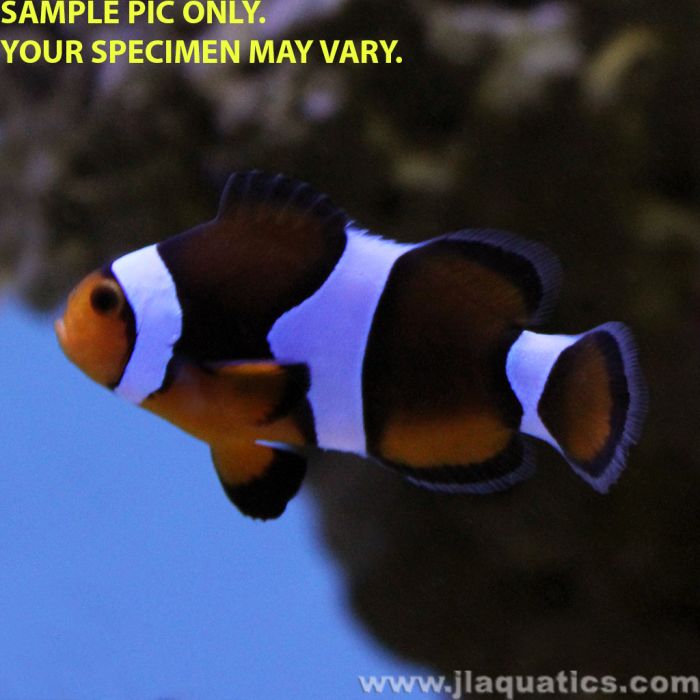Black Photon Clownfish (Tank Raised)
The Black Photon clownfish is notable for its intense black coloration on its upper half, and maintaining bright orange around the face, belly and lower fins. This was made possible because it is a hybrid between the Black Ocellaris and the Onyx True Percula. Young fish may be orange all over, but as it matures its black color will develop.
Cross breeding an Ocellaris with a True Percula clownfish creates a fish which physically an behaviorally resembles both parents. It may grow up to 4 Inches but in most cases not over 3 Inches. It needs an aquarium of at least 15 gallons for a single or pair. Dominant clownfish rarely accept other clownfish besides their mate within their territory, so singles or pairs work best.
This hybrid clownfish may be paired with either an Ocellaris or True Percula as a mate. It is very rare for another species to bond with it; more commonly fighting occurs.
Juvenile fish may need to 'grow into their stripes'; very young individuals may show very little striping, but when mature they have vivid colors.
They may host with nearly any anemone species, except Atlantic species. Best hosts are Magnifica/Ritteri (Heteractis magnifica) or Carpet (Stichodactyla sp.), however Bubble Tip (Entacmaea quadricolor) and Sebae (Heteractis crispa) are also popular choices.
Clownfish are hardy, easy to keep and are a perfect first fish for a new aquarium. Most species are available tank bred. They are omnivorous and easy to feed on high quality food items such as frozen Mysis shrimp, enriched brine shrimp, and dry foods, preferably more than once a day.
Clownfish are well known for their charming wiggling way of swimming, which serves them well in their natural home, within the stinging tentacles of an anemone. The exact reason clownfish are not stung is not known, but it may have something to do with the fish's slime coat. In the ocean, without the protection of the anemone, clownfish would be easily picked off by predators. In an aquarium the anemone, which has much more demanding needs than the fish, is not necessary. The fish may instead host with a soft coral such as furry mushrooms, toadstool leather, colt coral, or even within macro algae. It may choose to host within large polyp stony corals such as Euphyllia sp. as well, however the coral does sting the fish. We don't recommend encouraging them to host with delicate corals such as bubble or brain type corals, which the fish may injure with its constant swimming. Even with an anemone in the aquarium the fish will chose to host with whichever home it likes best.
Clownfish may be kept singly, or more commonly in pairs, in which case the smallest more submissive fish remains a male, and the largest most dominant fish changes sex to become a female. Clowns are related to damselfish, and pairs will not tolerate other species of clownfish within their territory (which may include 50 gallons of space or more) and may fight to the death. They are prone to parasitic infections such as Brooklynella and velvet.
It is common for pairs of clownfish to spawn in the aquarium, and pairs in their prime may lay eggs near their nest site as often as every two weeks. It is not necessary to interfere with the parents, who may become more aggressive at this time, chasing away other fish and nipping at their owner's hands. It is possible, though laborious, to raise the young fish at home. If a breeding effort is to be attempted, it is important to ensure the parent fish are of the same species in order to maintain genetic purity for future generations.
















